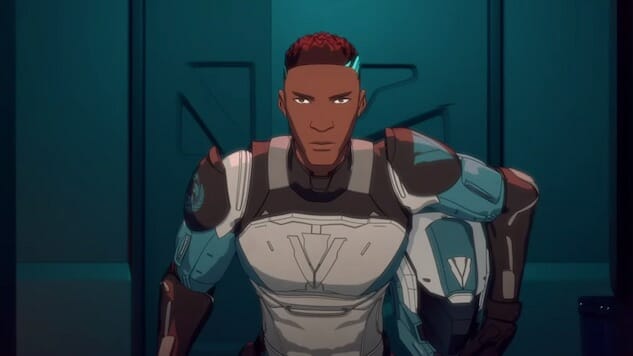So Evangelion Got You Hooked on Mecha Anime? Time to Watch gen:LOCK
Photo Courtesy of Rooster Teeth TV Features gen:LOCK
Neon Genesis Evangelion’s arrival on Netflix was a huge boon for the beloved anime, which got to infect a new audience with mecha fever while reminding even the most critical fans of the redub why the trippy mecha show was such a big deal in the first place. The former lot, or those intrigued by NGE but held at arm’s length by the show’s psychological intensity, may find their next obsession in Rooster Teeth’s gen:LOCK. Aring now on Adult Swim’s Toonami after premiering on Rooster Teeth’s streaming service earlier this year, gen:LOCK is another story about bodies, mechs, and the heady question of personhood that gets oh-so-complicated when technology is pushed to its sci-fi extreme. And it’s a lot easier to swallow than NGE.
With voice actors spanning the most popular genre properties in pop culture, from the MCU’s Michael B. Jordan to Game of Thrones’ Maisie Williams, gen:LOCK is—more than any of the Transformers shows or even Voltron: Legendary Defender—trying to give brainy mecha anime a decidedly Western spin. There’s a lot of Pacific Rim here. The intentionally diverse cast, the neural connection to the mega-machine: this is a show interested in the less monstrous aspects of Guillermo del Toro’s film and the philosophical elements of NGE, told through the vocabulary of fast-paced action TV.
Julian Chase (Jordan) is your Brooklyn-proud, everyman fighter pilot, readying for the coming war between his Polity and the enemy Union, when New York is invaded by an army empowered by swarms of murderous nanobots. He saves the day by launching an EMP, crashing his plane in the process, and is presumed dead. Four years pass and the war goes on. Then Chase shows up again out of the blue—controlling a giant mecha with his brain. His ex, fellow pilot Miranda (Dakota Fanning), is understandably a little freaked out. But Chase is now confined to a Luke Skywalker-esque bacta tank, with only his upper half surviving the crash. He, along with a few select recruits, are able to temporarily upload their minds into color-coded mechas called Holons. No mere link, no augmented piloting—he IS that big robot.
So yes, the NGE vibes are strong. Dr. Rufus Weller (David Tennant) is the mastermind behind the technology, the one that wishes his pilots a happy second birthday upon their rebirth as machines, and he’s obviously not telling them everything. Its mind-uploading gimmick is just one aspect of its post-human sci-fi. The formless, ambiguous terror of nanotech—malignant purple clouds of technology that can shut down anything and kill people …(somehow)—is a constant threat. It’s not post-human, but inhuman. There’s also plenty of VR cyberpunk in there too, with the Neuromancer and Ready Player One references resonating through its recreational mind-displacement as strongly as Ghost in the Shell colors its central plot.
But gen:LOCK doesn’t get hung up on things like the philosophical question of Swampman. The show is far more interested in how these elements translate to action and not the other way around. The show gets to the body horror much quicker than Evangelion, with the robots wearing their sinewy connectors and muscle-like structures on full display. The organic bent to these kaiju-sized robots is never up for discussion. With little time for a twisty slow-burn, much of the subtext and metaphor found in NGE become text in gen:LOCK. Psychological trauma is discussed openly and the relationships between the pilots are refreshingly frank. The identity crisis and shattered psyches that arise aren’t hidden for long, if at all, and handled with therapeutic optimism. That means both those deep into their mecha journey or just beginning will find novelty in a subgenre often happy to slap a new coat of paint on an old model Jaeger.
Aside from its relative straightforwardness—a product of blazing through lots of story in eight half-hour episodes (something that can’t be said of series with similar action-to-conversation ratios)—gen:LOCK’s production elements solidify it as a quintessentially Western entry into the mecha anime canon. Its meticulous action choreography is done on 2s (basically using 12 drawings to animate the 24 frames used in a second), giving its 3-D CGI some stylistic flair found in things like parts of Spider-Man: Into the Spider-Verse.
Sometimes that means it feels more like zooming through a comic book’s panels than watching a traditional anime, as montage images fade into or through one another as the camera never stops moving. Enhanced with a soundtrack featuring Louis Jordan’s blues and Richie Branson’s rap, the show feels quintessentially different from traditional mecha fiction; its near-future melting pot setting isn’t Neo-Tokyo, but New York, Dallas, Atlanta, and Chicago. Mecha anime may not be changed forever by gen:LOCK, but for those looking to make the move from the subgenre’s iconic series to a unique modern spin, the show is trying to be as A-list and mainstream as possible—and doing it well.
gen:LOCK makes it cable debut on Adult Swim Friday, August 2nd.